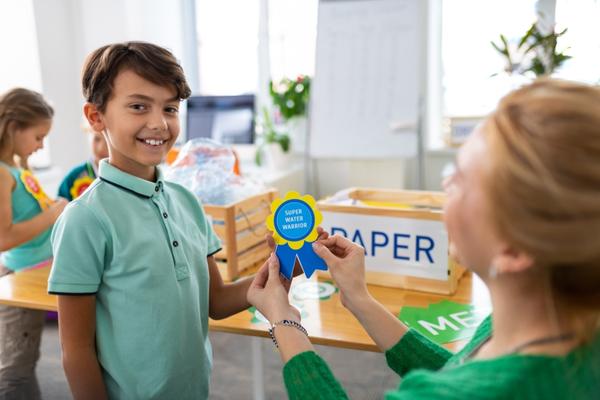Kids love to celebrate a victory, whether it’s a good grade or coming first in the 100m sprint at the athletics carnival, it’s a time for excitement and often, ceremony. It is essential for teachers to motivate and reward students in school to ensure that they are engaged, interested, and enthusiastic about learning. Students who are motivated are more likely to participate, take ownership of their learning, and succeed academically. In this article, we will look at various strategies that teachers can use to reward and motivate their students at school.
Celebrating these achievements acts as recognition of a job well done, and encouragement to keep up the good work. Certificates, prizes, medals, trophies, and awards are all great ways of acknowledging success, and sometimes something as simple as a formal letter home to parents or a stamp on the hand is all the encouragement a child needs to keep working hard to succeed.
While this age-old reward system is great for kids who can work hard and achieve a successful outcome, it tends to exclude kids who, despite their hard work and effort, may not be able to achieve “success” in the traditional sense, such as grades and sporting victories.
Rewarding only those who finish a race or get a certain grade means passing up an opportunity to recognise and celebrate the effort and hard work of others. Unlike the “everyone gets a trophy” philosophy, celebrating positive actions, hard work, and effort rather than simply “showing up” helps with long-term motivation and habit formation. Rewarding genuine effort rather than just success encourages children to accept a challenge and take on new and potentially daunting tasks and activities, rather than shrinking into the shadows and giving up trying.
Every child has something to offer, and kids are more motivated when their efforts and improvements, no matter how small, are acknowledged and celebrated. Rewarding effort and improvement over time develops self-motivated students, who can then gain greater control over their learning and achievements. Here are some effective ways to motivate and reward students at school:
Praise and Recognition
Motivational psychologist Carol Dweck studied the effect of rewarding effort vs. achievement. According to Dweck, when we tell our children they are “smart,” and reward them based on their achievements, we set them up to avoid activities and tasks that may not come to them so easily, causing them stress, when a problem arises, and outsmarts them. She found that if we praise their effort instead, we encourage students to take on tasks knowing that if they depend on their hard work and effort, and not their “smarts” it will help them to succeed, helping them to overcome any academic challenges they may encounter. Students are more likely to engage in positive behaviours and work harder when they feel valued and appreciated. Educators can offer praise and recognition in a variety of ways, including:
- Positive Feedback: Giving students positive feedback on their work, effort, or behaviour can boost their confidence and self-esteem. When educators recognise students’ accomplishments and progress, they feel valued and are motivated to continue working hard.
- Compliments: Passing compliments to kids like “Great job!” or “I’m proud of you!” can help motivate students. These small gestures demonstrate to students that their efforts and hard work are noticed and valued.
- Public Recognition: Recognising students’ accomplishments in front of their peers, parents, or school community can be a powerful motivator. It not only rewards the student but also sets a good example for others to follow.
Personalised Rewards
Personalised rewards are customised to the interests and preferences of each student. Students are more likely to feel valued and motivated when educators use personalised rewards. Here are some examples of personalised rewards:
- Tangible Rewards: Stickers, pencils, and certificates are examples of tangible rewards that can be used to motivate students, particularly younger students. Certificates and awards provide students with tangible forms of recognition that they can proudly display at home or among their peers. They serve as a reminder of their hard work and accomplishments, motivating them to strive for excellence in the future. Giving students a sticker for completing their homework on time, or a certificate for achieving an excellent grade, for example, can be motivating.
- Intrinsic Rewards: When compared to tangible rewards, intrinsic rewards such as praise, recognition, or positive feedback can be more effective. When students are praised for their efforts, they feel a sense of accomplishment and pride, which can inspire them to work harder in the future.
- Choice-based Rewards: Offering a choice-based reward system to students can be motivating. Allowing students to choose between a small prize and extra free time, for example, can motivate them to work harder.
Motivating and rewarding students is an important aspect of education. It not only improves academic performance but also boosts students’ self-esteem and confidence. Teachers can create an environment that encourages students to excel academically and personally by providing positive feedback, fostering intrinsic motivation, setting goals, celebrating success, and offering rewards and incentives. Students who are motivated and rewarded are more likely to enjoy learning, participate in classroom activities, and become active learners. They are also more likely to develop a lifelong love of learning, which is critical for future success. As a result, it is critical that teachers prioritise motivation and reward strategies in their classrooms in order to help students achieve their goals.

